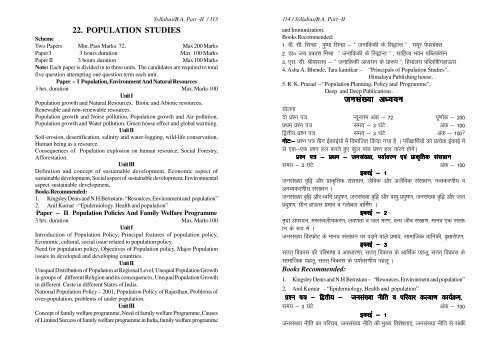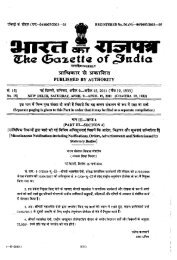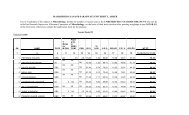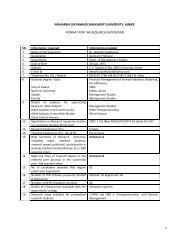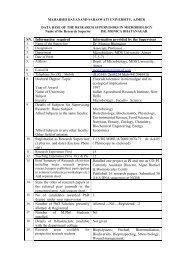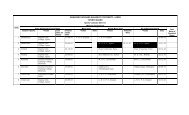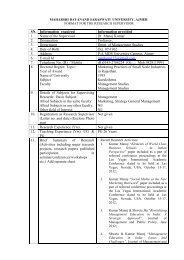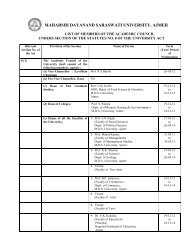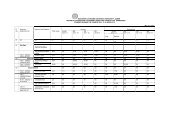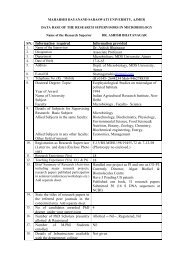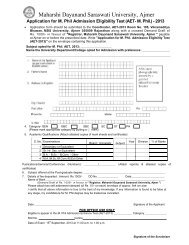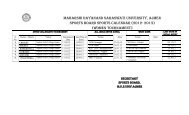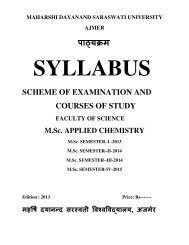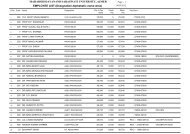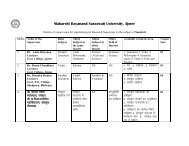ba pt II - Maharshi Dayanand Saraswati University, Ajmer, Rajasthan
ba pt II - Maharshi Dayanand Saraswati University, Ajmer, Rajasthan
ba pt II - Maharshi Dayanand Saraswati University, Ajmer, Rajasthan
You also want an ePaper? Increase the reach of your titles
YUMPU automatically turns print PDFs into web optimized ePapers that Google loves.
22. POPULATION STUDIES<br />
Scheme<br />
Two Papers Min. Pass Marks: 72, Max 200 Marks<br />
Paper I 3 hours duration Max 100 Marks<br />
Paper <strong>II</strong> 3 hours duration Max 100 Marks<br />
Note: Each paper is divided in to three units. The candidates are required to total<br />
five question attem<strong>pt</strong>ing one question term each unit.<br />
Paper – I Population, Environment And Natural Resources<br />
3 hrs. duration Max. Marks 100<br />
Unit I<br />
Population growth and Natural Resources, Biotic and Abiotic resources,<br />
Renewable and non-renewable resources.<br />
Population growth and Noise pollution, Population growth and Air pollution,<br />
Population growth and Water pollution, Green house effect and glo<strong>ba</strong>l warming.<br />
Unit <strong>II</strong><br />
Soil-erosion, desertification, salinity and water-logging, wild-life conservation,<br />
Human being as a resource.<br />
Consequences of Population explosion on human resource, Social Forestry,<br />
Afforestation.<br />
Unit <strong>II</strong>I<br />
Definition and conce<strong>pt</strong> of sustainable development, Economic aspect of<br />
sustainable development, Social aspect of sustainable development, Environmental<br />
aspect sustainable development,<br />
Books Recommended:<br />
1. Kingsley Denis and N.H.Bernstam- “Resources, Environment and population”<br />
2. Anil Kumar -“Epidemiology. Health and population”<br />
Paper – <strong>II</strong> Population Policies And Family Welfare Programme<br />
3 hrs. duration Max. Marks 100<br />
Unit I<br />
Introduction of Population Policy, Principal features of population policy,<br />
Economic, cultural, social issue related to population policy.<br />
Need for population policy, Objectives of Population policy, Major Population<br />
issues in developed and developing countries.<br />
Unit <strong>II</strong><br />
Unequal Distribution of Population at Regional Level, Unequal Population Growth<br />
in groups of different Religion and its consequences, Unequal Population Growth<br />
in different Caste in different States of India.<br />
National Population Policy – 2001, Population Policy of <strong>Rajasthan</strong>, Problems of<br />
over-population, problems of under population.<br />
Unit <strong>II</strong>I<br />
Conce<strong>pt</strong> of family welfare programme, Need of family welfare Programme, Causes<br />
of Limited Success of family welfare programme in India, family welfare programme<br />
Syllabus/B.A. Part -<strong>II</strong> / 113 114 / Syllabus/B.A. Part -<strong>II</strong><br />
and Immunization.<br />
Books Recommended:<br />
1- oh- lh- flUgk ] iq"ik flUgk & Þ tukafddh ds fl}kUr Þ ] e;wj isijcsDl<br />
2- Mkå t; izdk’k feJk Þ tuakfddh ds fl}kUr Þ ] lkfgR; Hkou ifCyds’ku<br />
3- ,l- lh- JhokLro & Þ tuakfddh v/;;u ds izk:i Þ] fgeky; ifCyf’kaxgkÅl<br />
4. Asha A. Bhende, Tara kanitkar – “Principals of Population Studies”,<br />
Himalaya Publishing house.<br />
5. R. K. Prasad –“Population Planning, Policy and Programme”,<br />
Deep and Deep Publications.<br />
tula[;k tula[;k v/;;u v/;;u<br />
v/;;u<br />
;kstuk<br />
nks iz’u i= U;wure vad & 72 iw.kkZd & 200<br />
izFke iz’u i= le; & 3 ?kaVs vad & 100<br />
f}rh; iz’u i= le; & 3 ?kaVs vad & 100\<br />
uksV%& uksV%& uksV%& iz’u i= rhu bZdkbZ;ksa esa foHkkftr fd;k x;k gS A ijh{kkfFkZ;ksa dks izR;sd bZdkbZ esa<br />
ls ,d&,d iz’u gy djrs gq, dqy ikap iz’u gy djus gksxsaA<br />
iz’u iz’u iz’u i= i= & & izFke izFke & & tula[;k] tula[;k] i;kZoj.k i;kZoj.k ,oa ,oa izkd`frd izkd`frd izkd`frd lalk/ku<br />
lalk/ku<br />
le; & 3 ?kaVs vad & 100<br />
bdkbZ bdkbZ & & 1<br />
1<br />
tula[;k o`f} vkSj izkd`frd lalk/ku] tSfod vkSj vtSfod lalk/ku] uO;dj.kh; o<br />
vuO;dj.kh; lalk/ku A<br />
tula[;k o`f} vkSj /ofu iznq"k.k] tula[;k o`f} vkSj ok;q iznq"k.k] tula[;k o`f} vkSj ty<br />
iznq"k.k] xzhu gkÅl izHkko o Xykscy okfeZax A<br />
bdkbZ bdkbZ & & 2<br />
2<br />
e`nk vijnu] e:LFkyh;dj.k] yo.krk o ty Hkj.k] oU; tho laj{k.k] ekuo ,d lalk/<br />
ku ds :i esa A<br />
tula[;k foLQksV ds ekuo lalk/ku ij iM+us okys izHkko] lkekftd okfudh] o`{kkjksi.k]<br />
bdkbZ bdkbZ & & 3 3<br />
3<br />
lrr~ fodkl dh ifjHkk"kk o vo/kkj.kk] lrr~ fodkl ds vkfFkZd igyw] lrr~ fodkl ds<br />
lkekftd igyw] lrr~ fodkl ds i;kZoj.kh; igyw A<br />
Books Recommended:<br />
1. Kingsley Denis and N.H.Bernstam – “Resources, Environment and population”<br />
2. Anil Kumar - “Epidemiology. Health and population”<br />
iz’u iz’u i= i= & & f}rh; f}rh; & & tula[;k tula[;k tula[;k uhfr uhfr o o ifjokj ifjokj dY;k.k dY;k.k dY;k.k dk;ZØe]<br />
dk;ZØe]<br />
le; & 3 ?kaVs vad & 100<br />
bdkbZ bdkbZ & & 1<br />
1<br />
tula[;k uhfr dk ifjp;] tula[;k uhfr dh eq[; fo’ks"krk,a] tula[;k uhfr ls lacaf/


